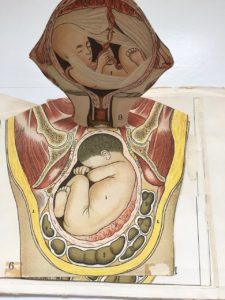– by Wood Institute travel grantee Maureen Cummins*
I spent a fascinating week this past summer at the Historical Medical Library of the College of Physicians of Philadelphia conducting research for a limited-edition artist’s book, Commitment. Like many of my titles, Commitment is a double-entendre, referring both to a marital or romantic bond and hospitalization for insanity. Suffice to say, the project explores the connection between intimate human relationships and mental illness.
As a visual artist, working in archives has been essential to my process. I often play with the sense of reverence that people bring to official knowledge and history, juxtaposing found photographs, documents, and ephemera in ways that create new and disturbing meanings. In Anatomy of Insanity, for example, I made use of patient records from McClean Hospital, one of the oldest mental hospitals in the United States, to demonstrate the gendered history of diagnoses. (As I wrote in my artist statement, “Men went crazy for all kinds of reasons, while women went crazy because they were women.”)
When I arrived at the College of Physicians last June, I was carrying my iphone, a notebook, and a list of search topics that fit well within my thematic umbrella: “hysterical” women; instruction manuals for young wives and husbands; the gendered history of electroshock and psychosurgery; the framing of alternate sexualities as deviant, criminal, diseased, or insane; jealous rage as a justification for crimes of “passion;” sexualized violence in general; and the high rate of suicide among single heterosexual men and LGBTQ youth. I planned to look at a variety of books and other printed matter. I was also interested in objects and images, which I have always considered to be as meaningful as texts. Even before I submitted my first call slip, I was photographing the file boxes on display above the main desk:
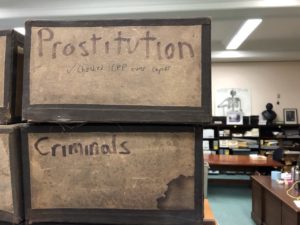
During my time in the reading room, a treasure trove of materials passed through my hands, everything from Swedenborg’s 1768 treatise on conjugal love, which stated that “The wife cannot enter into the duties proper to the man,” to 1960s ads for tranquilizers, “Mother’s Little Helpers.” I perused charts from 1905 that correlated incest with various forms of mental illness (Health and Disease in Relation to Marriage and the Married State) and government-issued divorce statistics from 1963, when women comprised three-quarters of plaintiffs in the U.S.I looked through the papers and case histories of renowned medical men: Neurosurgeon Frances Clark Grant; Walter Freeman, the infamous lobotomist; and Silas Weir Mitchell, the physician who treated Charlotte Perkins Gilman with his “rest cure” for hysteria.
As an artist-in-an-archive, my job is to notice things. What I noticed most about the materials I was perusing were how crazy-making they were in their own right: Families were a must, but not overly large ones. “Puny, sick, short-lived offspring follows over-production,” (The Physical Life of Woman, 1869.) Women were the “weaker vessel” (What a Young Husband Ought to Know, 1897) but were obliged to bear children and run households and be loving wives and mothers. “We are first of all homemakers,” (The Homemaker…, 1969). If a woman chose to have an abortion it would be better that she “die…in the pangs of childbirth, than to live with such a weight of sin on the conscience,” (The Physical Life ofWoman, 1869).
One of the most physically beautiful books that I handled, the 1874 Wedlock, or the Right Relation of the Sexes, was also the most hateful: to decide not to marry was an “act of disobedience which cannot go unpunished.”Women who failed to find husbands were informed, “Fire will burn you all the same.” In the eugenics-era text, Manhood and Marriage(1929),it was suggested that women with cancer consider sterilization. And as late as 1968 a woman over fifty was described as having “passed her best years.” (The Emotional Basis of Illness: Woman—the Mature Years and Beyond)
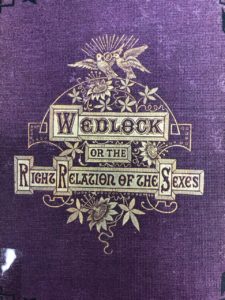
The male sex was not immune to such contradictory and terrifying messages. Men were advised against “excessive indulgence, which injures the health of women,” (What a Young Husband Ought to Know, 1907) but warned against both celibacy, which “predisposes to insanity” (A Manual of Psychological Medicine, 1868) and “the crime of onanism” which led to “many instances of insanity.” (Nervous Exhaustion and the Diseases Induced by It, 1873). Infidelity was not only a mortal sin, it also caused venereal disease, another path to insanity.
For gay or other non-gender normative men, the outlook was even bleaker. Havelock Ellis’s 1901 Studies of the Psychology of Sex: Sexual Inversion, while being the first serious study of homosexual men and non-gender-normative individuals, was also rife with Ellis’ Eugenicist attitudes. In the book, the causality of “perversions” were divided into two categories, “Acquired sexual perversion” and “Congenital and perhaps hereditary sexual perversion.” As recently as 1969, any number of sexual expressions now considered normal were classified in the DSM as “deviations.”
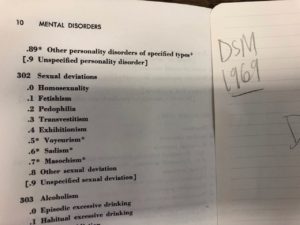
It was impossible not to read many materials through the lens of rape culture. In The Repair of Will-loss, neurotic and pregnant girls “changed as if by magic when they became joined in lawful wedlock to their seducers.” The 1895 book Abnormal Woman: A Sociologic and Scientific Study of Young Women, Including Letters of American and European Girls in Answer to Personal Advertisements appeared to be written by a stalker posing as a scientist. Similarly, the 1966 Thorazine Reference Manual, which, with its coded,gendered language, read like a how-to guide for sexual abusers: “Thorazine’s ability to convert highly disturbed behavior into docile tractability has remained an impressive phenomenon. Agitated, anxious, openly hostile, assaultive, excited, aggressive, fearful, and resistive patients become quieted and calm…. Under the initial influence of Thorizine, patients…. may sleep during most of the first day or so….They are orderly, follow directions….and are easily managed.”
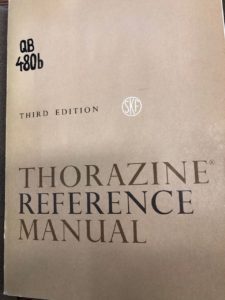
As an artist, my ultimate task is to translate the patterns that I observe into a powerful visual language that can be readily accessed and interpreted by my reader/viewer.One of the ways I achieve this is to find a form that will not only provide a container for texts and images, but also convey a mood / meaning / message in its own right. Often the forms I choose relate to books. For example, I worked with aluminum clipboards for The Rapist, a book about the career of lobotomist Walter Freeman.In the case of my current research, I found it challenging, as a modern reader, to take seriously such manipulative, histrionic, and outrageous messages. At the same time I was well aware of the effect of these messages on the actual lives of men, women and children. My impulse was to juxtapose the comic and the frightening in a form that could be physically manipulated or “toyed with” by the reader.

In the end, the forms that I was attracted to, and will be drawing upon for Commitment, are paper dolls, anatomical models known as écorchés…
…and movable toys. I also plan to incorporate two 19th century engravings that appear uncannily similar: one is of a bridal dress, the other is of a straitjacket.

My current plan is to transform these engraved torsos into full-figure paper dolls that will, as the reader turns the pages and encounters bizarreries such as the texts excerpted above, alter in ways that reveal my postmodern sensibility. Eyes will pop, mouths will grow increasingly wide, grommeted limbs will flail. In this way, I aim to create a movable book that expresses all the rage I was forced to contain while reading quietly in the Historical Medical Library.
*Maureen Cummins received an F.C. Wood Institute Travel Grant from the College of Physicians of Philadelphia in June 2019.

